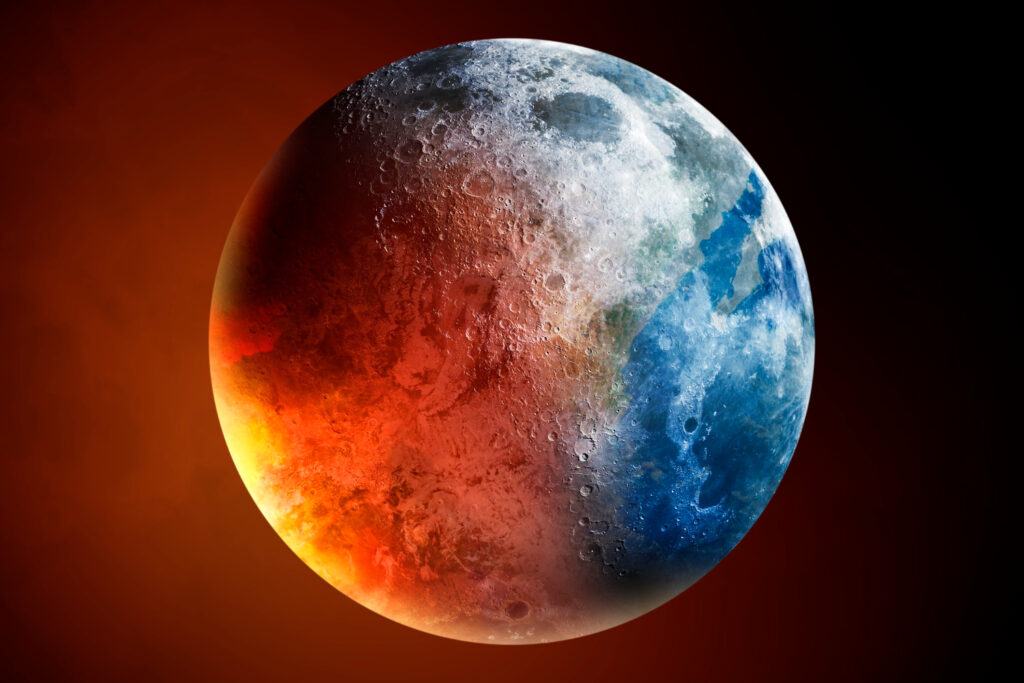When the Earth rotates, one-half of it faces the Sun at any given time and experiences daytime, while the other half is facing away from the Sun and experiences nighttime. It takes 24 hours for the Earth to rotate its axis completely. The axis is the imaginary straight line that extends from the North Pole to the South Pole. Most organisms’ biology highly depends on the day and night on Earth, making this cycle highly vital for their survival.
It is vital to understand how Earth’s rotation causes day and night, changes in seasons, and how it impacts life on Earth. Not only does it help in the student’s academics, but it also helps them understand how life remains in harmony with nature. Being one of the best schools in Vadodara, Nalanda International School strives to offer a balanced teaching methodology to its students, enabling them to understand these crucial topics easily.
Let’s learn how the Earth’s rotation causes day night cycle on Earth:
The Sun
Day and night are caused by the rotation of the Earth around its axis, making it look like the Sun is moving across the sky. It takes 24 hours for the Earth to complete a rotation. The Sun is the center of our solar system and sustains life on Earth. It was formed 4.5 billion years ago from a molecular cloud made of hydrogen and helium. After the gas in the core heated up, nuclear fusion began. The resulting atoms released energy in the form of heat and light.
The Sun is divided into six different layers and zones: the core, radiative, convective, photosphere, chromosphere, and corona. The outermost layer, the corona, is surrounded by solar wind. The teaching modules in Nalanda International School are designed so that students can easily understand even the toughest topics, making us one of the top schools in Vadodara.
The Earth’s Axis
All solid objects in space spin around an axis. This axis is an invisible line running through the center of an object. Earth’s axis is tilted by about 23.5 degrees, called the axial tilt or obliquity of the ecliptic. This axial tilt affects where the Sun shines during different seasons. This is why the hemispheres of the Earth have different seasons: summer occurs when the axis is tilted towards the Sun, and winter occurs when it is tilted away from the Sun.
When the Earth orbits the Sun, it spins around an axis. Over long periods (between 19,000 and 24,000 years), the direction of Earth’s axis shifts slightly, a process known as nutation. This motion also changes the position of the Sun and the Moon around the Earth. Because the axis tilts, different parts of Earth receive more or less of the Sun’s direct rays at certain times, causing day night cycle on Earth.
The Earth’s Rotation
The Earth is a sphere that rotates around the Sun. The side facing the Sun is bathed in light and heat, while the other side faces away into space and experiences nighttime. This rotation causes the Earth to change its position from one side of the Sun to another, allowing daylight and nighttime to last longer in extreme places like the North and South poles. A day on the Earth lasts 24 hours – that’s how long it takes for the planet to rotate once on its axis.
The Earth’s rotation is one cause of day and night and is governed by gravity, which makes it slightly oblate, with a bulge in the center. This is due to the Moon’s tidal force and its interaction with the Earth’s spin axis. Tidal acceleration has slowed the Earth’s rotation significantly over millions of years. Our teachers at Nalanda International School ensure that our students understand these terms and their significance well in detail.
The Earth’s Surface
Because of the day and night earth rotation, the surface of the Earth changes through gravity, wind, ice, water, and the movement of tectonic plates. These processes can change Earth’s surface into many different landforms. The Sun heats Earth’s surface by a process called solar heating. The Earth’s surface heats up and cools down again during a typical day. Understanding such crucial topics with the help of practical classes and student-centric teaching methodologies is highly essential.
The surface temperature is influenced by the Sun’s rays, which are absorbed, reflected, or transmitted by the atmosphere, and then returned to the surface. Scientists also track the way the Earth rotates and make measurements of it. This helps scientists explain what is happening under the surface of the Earth, like earthquakes and volcanoes.
The Sun’s Radiation
The day and night are caused by the motion of Earth around the Sun. The Sun emits radiation in various spectral bands, including ultraviolet, visible, and near-infrared light. The radiation is absorbed by Earth’s atmosphere, but much of it passes away. The amount of solar energy absorbed by the atmosphere depends on various factors and is termed as Greenhouse Effect, which causes the Earth’s temperature to rise.
Because the angle of incoming solar radiation varies from equator to pole, seasonal temperatures also vary. When the rays strike the surface near the equator, they are nearly perpendicular, causing them to be more concentrated over a smaller surface area, causing warmer temperatures. On the other hand, when the rays strike the surface at higher latitudes, they are less direct, causing cooler temperatures.

Definition of Day and Night Cycle
The day and night on Earth is a natural part of the solar system. It is caused by the rotation of the Earth on its axis and the tilt of the Earth’s axis relative to the path of the Sun. The length of this cycle depends on where you are on the planet and what time of year it is. In general, the day gets shorter as you move north or south. When you’re on the equator, daytime lasts about 14 minutes longer than night does. In contrast, the daytime gets shorter in winter the farther north you go. This is called an equinox.
A solar day is between two solar noons or times when the Sun reaches its highest point in the sky. A sidereal day is a time between two sunrises or sunsets in a particular location, as determined by the position of stars in the sky. Nature has created a cycle that is 24 hours long to accommodate the biological requirements of most organisms. Without the day-night cycle, plants and animals would be unable to survive.
Why Do We Experience Night and Day?
Day and night are an important part of everyday life. They are the two most important natural cycles on Earth and are also a part of our cultural identity. However, we often wonder why we experience both light and darkness. The answer is simple: the Earth rotates, which causes us to experience a day and night cycle. This rotation, which takes about 24 hours to complete, makes it possible for some parts of the planet to be bathed in sunlight and others in darkness.
To understand how day and night occur, it’s important to study the rotation of the Earth. This rotation of the Earth is a prograde rotation, which means that it spins in a direction from west to east. This causes the Sun to rise in the east and set in the west daily. Our axis of rotation is tilted at 23.5 degrees, which means that the North Pole always points towards Polaris (A star in the Milky Way). This has a big effect on how much surface is exposed to sunlight, and this affects our daytime and nighttime lengths.
What Two Factors Cause Seasons?
Seasons are a natural part of life on Earth, and each year we experience them in different ways. Some regions can see more or less of the Sun’s rays, while others experience a lot of rain or snow. This weather cycle is caused by a few factors, including Earth’s axis and orbit around the Sun. The Sun is the main source of heat for our planet. It shines directly on the surface of our planet, and its rays also hit the atmosphere at varying heights.
These rays can cause a difference in temperature between the land and the air. The ground absorbs more heat during the summer when the Sun is higher in the sky. In the winter, the Sun’s rays hit the atmosphere at lower levels. Ask students to find out how direct sunlight and indirect sunlight affect the seasons. They can use tools such as a thermometer, a graph, or an atlas to determine which type of sunlight is most likely to occur at certain times of the year.
This lesson can also be adapted to include the role of axis and tilt in the relationship between the Sun and Earth. The axis is a 23.5-degree tilt and causes different parts of the Earth to receive more or less sunlight. Axis and tilt are important because they cause the Northern Hemisphere to point toward the Sun during summer and away from the Sun during winter. The day night cycle on Earth is related to the occurrence of the seasons on the planet.
Several factors cause day and night, and studying them all is essential to understand what causes seasons and the day & night cycle on Earth. Axis and tilt are important because they affect how much sunlight reaches the ground and how high in the sky the Sun will appear to be at different times of the year. The axis is also responsible for causing our planet to move in an orbit around the Sun, which makes us change the length of our days and nights.
During the summer, Earth’s axis is tilted toward the Sun, and the hemispheres that are closer to it get more direct rays. This is why June, July, and August are considered the summer months in the Northern Hemisphere. When the axis is tilted away from the Sun, the hemispheres that are further from it get less direct rays, so the northern half of the Earth gets winter. This is why January and February are considered winter months in the Northern Hemisphere.
During the winter months, Earth’s axis is also tilted away from the Sun, and the farther hemispheres get less of the direct rays. This is because the rays that reach our planet are more diffuse, so they can’t penetrate as far. This is why the winter months are colder in the Northern Hemisphere than the summer months in the Southern Hemisphere. The axis of other planets, such as Mars, Venus, and Pluto, also play an important role in the seasonal changes on their planets.
Conclusions
Day and night occur on Earth because of its rotation around its axis. The Earth twirls around its axis every day, causing which side gets sunlight to change. That means that part of the Earth that faces the Sun experiences day, while the part that is away from the Sun experiences night. These cycles occur because the Earth’s axis is tilted. The northern half of the Earth is tilted towards the Sun in summer, resulting in longer daylight; it is retracted away in winter. The Hemisphere of the Earth that faces the Sun experiences daylight, while the opposite side experiences darkness. To learn more about how day and night occur, please visit one of our teaching staff at Nalanda International School now!

